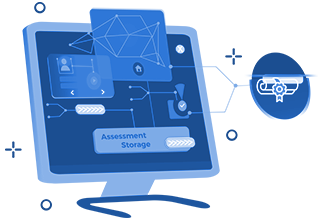u Overview

The structure and content of this step-by-step guidance on how to assess an academic credential issued outside Canada was developed on the basis of the European Area of Recognition (EAR) Manual and European Recognition Manual for Higher Education Institutions (EAR-HEI). It provides a pan-Canadian perspective and terminology.
u Learn about
the education systems in the 13 provinces and territories of Canada
Learn about the qualifications frameworks and the particular characteristics of the 13 education systems in Canada.
For internal procedures:
l Learn about the particular characteristics of the 13 provincial
and territorial education systems in Canada, such as:
² structure of the each
education system;
² types of educational
institutions within each classification structure;
² quality-assurance practices;
² legal framework, enabling
the:
n operation of
educational institutions (e.g., use of the term “university” in its name);
n delivery of
academic programs (e.g., vocational training registration);
n issuing of specific
academic credentials (e.g., authorization to issue degrees through ministerial
consent).
l Learn about the
types and levels of academic credentials typically issued within each of the 13
education systems through:
² their respective qualifications
frameworks;
² visual diagrams that illustrate the
various levels found in their respective systems.
u Learn about the education
system of the issuing country
Situate the academic credential in context by learning about the qualifications framework and particular characteristics of the relevant education system outside Canada.
For internal procedures:
l Learn about the
particular characteristics of the issuing country's:
² education system
structure;
² types of
educational institutions within its classification structure
² quality-assurance
practices
² legal framework
that enables the:
n operation of
educational institutions (e.g., the use of the term “university” in its name);
n delivery of
academic programs;
n issuing of specific
academic credentials (e.g., degrees).
² Learn about the
types and levels of academic credentials typically issued within this education
system:
n use the
qualifications framework (if one exists).
To obtain this information, consult the issuing country's Web sites and/or contact the competent authorities. These are usually the:
l government
ministry/department responsible for education;
l quality-assurance/accrediting
agency;
l licensing and
professional authorities for regulated occupations;
l national
information centre.
u Examine
various aspects of the academic credential
Use CAED's Directory of Offshore Schools and International Education Resources as a starting point to locate the names of competent authorities for specific countries.
l Examine
various aspects of the academic credential, such as:
² admission
requirements, in terms of meeting the acceptable threshold (e.g., Completion of
the High School Graduation Diploma);
² level,
within the developmental continuum (e.g., qualifications framework);
² workload,
as a quantitative measure of learning activities (e.g., hours, years, credits);
² overall
quality, as measured through:
n student
achievement (e.g., grades);
n the
academic program and educational institution (e.g., external quality-assurance
procedures);
² profile
describing the academic program's:
n content
(e.g., multi-, inter-, or mono-disciplinary);
n purpose
(e.g., further studies, direct labour-market entry, granting access to a
regulated occupation).
² learning
outcomes, highlighting what the credential holder is expected to:
n know;
n understand;
and
n demonstrate.
Detailed information may be readily accessible on the Web site of the issuing educational institution.
Some features may also be outlined in the Diploma Supplement, facilitating the assessment process. However, not all jurisdictions have adopted this recognition tool, and it does not always accompany documents.
u Compare
similar academic credentials issued within Canada
Find other academic credentials issued by institutions in Canada that may lead to similar outcomes.
For internal procedures:
l Examine
typical characteristics of a similar academic credential found in one of the
provincial/territorial education systems, such as:
² level;
² workload;
² overall
quality;
² profile;
² learning
outcomes.
l Identify
comparable academic credentials using:
² qualifications
frameworks;
² visual
diagrams that illustrate the various levels found in individual education
systems.
l Compare
your findings with the range of outcomes identified by the pan-Canadian
academic credential assessment community using CAED's Directory of
Comparability Assessment Outcomes;
l Consult
other internal and external resources to support your process. CAED's tool box
can support your research process and provide a space to consult with other
members of the pan-Canadian academic credential assessment community.
u Determine
whether there are any substantial differences
Compare both perspectives, ensuring a fair comparability process and enabling you to form an opinion on the outcome.
For internal procedures:
l Consult
precedents for any previous similar applications processed by your organization
in the past. It may be exactly the same or share similarities, such as the:
² issuing
educational institution;
² completed
academic program;
² academic
credential obtained after completion.
l Consult precedents from:
² within
the concerned jurisdiction;
² other
jurisdictions with a similar education system structure.
l Compare
your findings with the range of outcomes identified by the pan-Canadian academic
credential assessment community using CAED's Directory of Comparability
Assessment Outcomes;
l Document
the rationale for your decision if you found a substantial difference in the
comparability process. If a precedent is found, the written rationale used to
substantiate previous decisions may prove extremely useful;
l Consult
other internal and external resources to support your process. CAED's tool box
can support your research process and provide a space to consult with other
members of the pan-Canadian academic credential assessment community.
 English
English Français
Français 日本語
日本語 中文
中文 한국어
한국어 Русский
Русский











